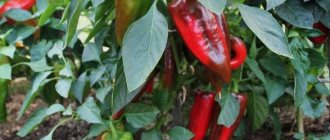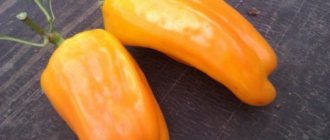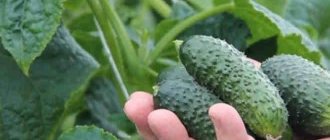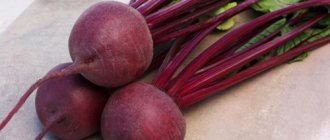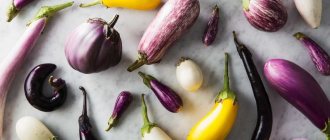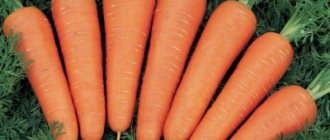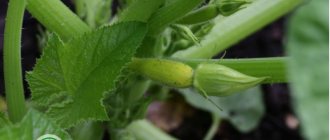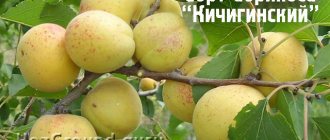The onion variety Stuttgarter Riesen was bred in Germany, and in Russia it was officially included in the register of agricultural products in the same 1995.
Dear readers!
For you, we have created communities on social networks in which useful articles and interesting ideas are published several times a day! Subscribe and receive useful content in a convenient format! It is considered a universal variety, suitable for growing both feathers and bulbs. Suitable for cultivation throughout the center of Russia, the Volga region and the central, southern parts of the East Siberian region.
The average yield is considered quite high and, with industrial cultivation, varies between 101-351 c/ha. The variety was specially bred for cultivation in temperate climates, as it has excellent resistance to frost and is famous for its strong immunity.
Description of the variety Stuttgarter Riesen
Well adapted to the climate of the areas where it is grown, having above-average yields and easily resisting many diseases and pests - this is all about the Stuttgarter Riesen onion variety. It is well suited for cultivation in Russia throughout the temperate zone. Moreover, in most situations it will have time to ripen and produce a high-quality, well-stored harvest, even if spring arrives late and in a relatively cold summer.
Appearance of the bulb
The Stuttgarter Riesen variety looks extremely classic for onions: it has yellow, golden or rich brown scales. The most important distinguishing feature of the variety is the bulb, which is slightly flattened at the top and bottom and is not perfectly round.
Their weight can vary from 70 to 200 grams, but in general it can be noted that they are either medium or very large in size.
Ripening time and ripening
Moderate temperatures and long, dry summers are ideal conditions for the ripening of the Stuttgarter Riesen variety. However, in some northern territories it is possible to grow the crop quite calmly, obtaining good harvests year after year.
In the south, the first harvests are expected from the end of May. In the middle zone - in June-July. And in regions with short summers, onions will almost always have time to ripen before the first frost in late summer or early autumn. The variety will survive low temperatures and even frosts, as it is early.
Purpose of the variety
The variety is best suited for growing as bulbs. But it is known that greens from it also have a classic aroma and taste. True, it grows a little more sparingly than on some other onion varieties, which sprout leaves more readily.
Productivity
The collection of bulbs is highly dependent on weather conditions. The drier the spring and the first part of summer, the more sunny days, the better and faster the bulbs of the Stuttgarter Riesen variety ripen and its green mass grows.
However, even under unfavorable conditions, the total yield per 1 m2 rarely falls below 3-4 kg of bulbs. And under optimal conditions and, which is quite important, good fertilizing (it is enough to do it at least 2 times in the spring), you can increase the crop yield by 40-60%.
Transportability
Stuttgarter Riesen tolerates transportation well and practically does not lose its presentation. In many ways, all this is due to its rather peculiar feature - the solid structure of its protective scales.
BY THE WAY. This is even one of the often noted disadvantages of the variety, because its bulbs are more difficult to peel.
Keeping quality
Many people note that Stuttgarter Riesen is stored very well and for a long time. It is only important that before storing for a long period of storage, do not forget to sort and put the best bulbs separately from those that look suspiciously soft or uneven in color.
The bulbs are supposed to be stored in a completely standard way: hanging from the ceiling or putting them in dry, well-ventilated bags, nets, or stockings. The main thing is that the room where onions of this variety are stored is not humid, with a constant low temperature and a minimum of natural light.
Taste
The taste of Stuttgarter Riesen onions is classic. It is dominated by slightly spicy notes, with noticeable sourness (the variety is very rich in vitamin C) and a noticeable pungency. The aroma is distinct and traditional.
Disease resistance
Many early varieties of garden crops have excellent immunity. This case is no exception.
This onion variety is really rarely affected by diseases and is not particularly liked by pests. Throughout the entire growing period, 1-2 pest control treatments are usually sufficient, and even then they are often purely preventive in nature.
Breeding ways to solve problems
Specialists from the Netherlands (agricultural breeders) have developed an improved version - the non-hybrid variety Stuttgarter-Stanfield (Stanfield), zoned in Russia since 2015 (based on the results of tests in the Central region). It is devoid of many of the disadvantages of the original form, maintaining good performance in terms of yield and bulb size.
Varietal characteristics of Stuttgarter-Stanfield onions:
- three-germ, which means a lush feather;
- thin “neck”;
- resistance to fungal infections;
- completion rate for harvesting – 88%, when ripening – almost 100%;
- the shape is less flat, closer to an ellipse;
- average bulb weight 85-100 g;
- industrial productivity of turnips is from 180 to 380 kg per hundred square meters.
Stuttgarter-Stanfield grows bulbs later (in the middle terms), so it is not a complete replacement for the original early variety. Future tests will show whether the new product will be able to displace the maternal form. The stable genetics of “old”, reliable varieties are not always ready to give up ground even in front of disease-resistant new forms.
Advantages of the Stuttgarter Riesen variety
The Stuttgarter Riesen onion variety was first bred in Germany, and only then spread throughout the world. Today it is one of the most popular onion varieties in the temperate zone of the globe. It is grown in Europe, Asia and America.
ON A NOTE. The Stuttgarter variety is considered one of the richest among garden onions in terms of vitamin C content in the bulbs and feathers.
This onion is valued for many positive properties:
- Very low maintenance.
- Good adaptability to the climate of the growing region.
- Early maturation.
- Lasting immunity.
- High yield - on average it ranges from 4-8 kg per square meter of plot.
- Versatility: the variety is grown for both greens and bulbs.
- The bulbs and feathers have a classic taste and aroma.
- The bulbs fit well.
Selection history and growing regions
The Stuttgarter Riesen onion was bred by German breeders in the last century. The variety is sometimes considered Dutch because that country has a license to produce onion sets. Selection success has spread widely across different countries, but not everyone is able to reproduce the name without errors, so sometimes it is passed on as Stuttgarter Riesen or Stuttgarten Riesen. There is also a translated name - Stuttgart Giant (Giant from Stuttgart).
The German city of Stuttgart is located in a continental climate zone, contrasting in nature. The genes of onions originating from this area contain the highest ecological plasticity - the ability to develop in different conditions. In 1981, the Stuttgarter Riesen onion was accepted for varietal testing in Russia. Since 1995, it has been included in the Russian State Register (as Stuttgarter Riesen) and is recommended for cultivation in four regions: Central, Volga-Vyatka, Middle Volga and Eastern Siberia. The real geography is much wider. The Stutagrer Risen bow is in demand in many Russian regions and in the Near Abroad.
Disadvantages of the Stuttgarter Riesen variety
It is almost impossible to identify serious shortcomings in this bow. But there are only minor negative points noted in reviews of the variety:
- The bulbs are quite difficult to peel.
- It is believed that Stuttgarter Riesen is not well suited for growing for greens, as it produces fewer feathers compared to many other onion varieties.
- It is assumed that onions are suitable for growing in temperate climates and are not afraid of cold weather, and this is true. But, nevertheless, the culture grows better the warmer the climate.
- When humidity is high, prepare for a significant drop in yield. Mainly due to rotting bulbs. For example, this happens in rainy summers.
Advantages and disadvantages
The popularity of the German variety is explained by the presence of a number of advantages:
- early or mid-early turnip harvest time (it has time to ripen in all regions);
- high yields (from 3 to 5 kg per square meter);
- unpretentiousness in agricultural technology;
- excellent keeping quality, shelf life until spring;
- universal use;
- suitability for growing in spring for greenery at home;
- excellent taste;
- resistance to shooting.
The variety has beautiful bulbs, which makes it popular for growing for sale.
The disadvantages include the following:
- not very convenient shape of the turnip (flattened, with a notch at the neck);
- susceptibility to downy mildew and neck rot (manifests itself when the soil is waterlogged in the rainy season);
- unsuitability of onions for winter planting (only small-fraction sowing, which will dry out during storage).
The “pros” outweigh, especially since in a favorable season the variety produces excellent yields with minimal care.
Onion cultivation Stuttgarter Riesen
Due to the fact that the Stutrter Riesen variety is early, it can easily be grown to full maturity both from seeds (including planting them directly in open ground) and from onion sets. Moreover, this condition is typical not only for the middle zone, where most gardeners work in our country, but also for Siberia, the Urals, regions north of Moscow, the north-west of the country, and the Baltic states.
True, based on many opinions and reviews, it is recommended to grow sevcom crops in not the warmest and most stable climates, since this is a much simpler and more reliable way.
Growing from seeds
If you still give preference to seed cultivation, then two types of actions are permissible for this variety:
- Immediately sow outside.
- First, growing the seedlings, and then transplanting them to a permanent place.
In the first case, planting is done quite early, when the ground warms up to +5-7°C and the air to +10-15°C. This time usually falls in early or mid-April in most regions.
BY THE WAY . Seeds can also be planted before winter. But then, so that they do not have time to germinate, they do this already with the onset of the first frost.
Before planting, the seeds are soaked in a weak solution of potassium permanganate. Planted in ridges with a distance of 15-20 cm between them. Place 3-5 seeds together, then make 10 cm gaps.
After germination, the bulbs can be thinned out, or you can leave everything as is. There is no consensus on this matter.
Growing from seeds through seedlings
If spring usually comes late in the region and winters are cold, then it is more difficult to grow high-quality bulbs using the usual seed method. Then they resort to germinating seedlings.
The planting material is also soaked and disinfected, and then planted in specially prepared containers with a nutrient solution. They begin working with seedlings in mid-to-late February. And since at this time there is still not enough natural light, artificial supplementary lighting will have to be organized sometime before mid-March.
In mid-April or at most early May, the seedlings are transferred to a permanent growing place outside.
How to grow from onion sets
The main reason why they choose to grow the Stuttgarter Riesen variety is the early ripening period.
REFERENCE. Onion sets of this variety can be harvested 60-70 days after planting in open ground. And if you grow the crop with seeds, it will take at least 100-120 days.
It is important to choose good planting material. As you can see in many recommendations, experienced gardeners say that you need to select bulbs of a uniform color and always without visible damage.
Immediately before planting outdoors, it is advisable to warm the onion set well by placing it next to a radiator or stove for 8-12 hours.
The bulbs do not need to be soaked before planting, but spraying their surface with a weak solution of potassium permanganate will not hurt.
As is usually typical for onions, you need to sort the bulbs into large, medium, and small. They should be planted in separate beds: large with large, small with small, etc. You can plant it either before winter (then it is advisable to do this 3-4 weeks before frost, which is October-November), or in early spring in well-warmed soil (late April - May).
25-30 cm should be left between the furrows, and at least 10 cm between the bulbs themselves.
Features of agricultural technology
Video: When to plant onion sets in the Urals
Every agricultural technician knows that to obtain the maximum yield of Stuttgarter onions, you should choose fertile soil. Plants do not like an abundance of mineral salts, so it is better to use organic fertilizers to grow them. The best predecessors are:
- potato;
- tomatoes;
- cucumbers;
- leguminous plants;
- cabbage.
For sowing Stuttgarter onions, it is advisable to use fresh seed. When purchasing it in a store, be sure to pay attention to the expiration date. It is best if it ends not this year, but next year. Before sowing onion seeds in the garden, they should be warmed up near a radiator and then soaked in warm water for a day. It is recommended to add potassium permanganate to it in order to disinfect it at the same time.
Use fresh seed
The correct approach to growing Stuttgarter onions is to start preparing the area in advance. All soil characteristics are taken into account and measures are taken to improve them. If the soil in the garden bed is depleted, then it is necessary to fertilize it with rotted manure or humus. Acidic soil is deoxidized by adding lime, dolomite flour or ash. The latter will also serve as an excellent fertilizer for the bulbs. Preparatory work is carried out in the fall, even if the Stuttgart onion is planned to be planted only in the spring. In the future, you will only need to loosen the bed and make grooves on it, leaving a distance of at least 10 cm between them.
Stuttgarter seeds should be planted to a depth of no more than 2 cm, with a gap of 1.5 cm between them. After sowing, the soil is slightly compacted so that no voids form around the seed.
Worth remembering! Stuttgarter Riesen onions, the seeds of which are planted in the spring, are not afraid of low temperatures. However, most gardeners prefer to carry out planting work in early April. If autumn is chosen for this, then the beds will also need to be mulched. A mixture of peat and loose soil is used as a nutrient substrate. Peat can be replaced with humus.
Onion sets Stuttgarter Riesen can also be planted in spring or autumn. In the autumn, it is better to plant small things that will not be stored until spring, but by the beginning of summer they can produce a harvest of excellent young heads and greenery. In order to plant small seedlings, the bed should be prepared immediately after harvesting the previous plant. Onions are planted a month before the expected onset of cold weather, so that the heads have time to take root well. It is advisable to cover Stuttgarter with hay, fallen leaves or spruce branches to avoid freezing from the snow.
Reviews from gardeners indicate that the most daring and desperate managed to grow Stuttgarter, planting seedlings at the end of August or September. Before the onset of frost, the plants managed to produce a few leaves. However, in this case, the beds need to be covered with a material such as lutrasil or spunbond. As a last resort, lay the fallen leaves in a very thick layer. Light frosts are not a problem for Stuttgarter plantings, and a layer of snow will additionally protect them from frost. With the beginning of the thaw, the bulbs will begin to grow again.
To grow the first crop faster, before planting it is recommended to warm the seedlings near the radiator for 8 hours, and then soak them in warm water with potassium permanganate for a day. You can add a little agave juice to stimulate root growth in Stuttgarter onions. It is worth deepening the bulbs no more than a couple of centimeters. Planting is done in rows, between which a distance of 25 cm is left. The gap between the bulbs should be 15 cm.
It is recommended to warm up the seedlings near the battery before planting.
When growing Stuttgarter onions, turnips or large sets are selected for planting. They are stuck into the soil almost without gaps, and are not sprinkled with earth on top. To make the forcing process faster, you can cover the plantings with cellophane on top. Planting is allowed both in open ground and in a greenhouse.
Caring for Stuttgarter Riesen outdoors
Although it is known that this variety is very unpretentious, it is definitely worth knowing and following some secrets of proper care for it. This way you can grow a much better and tastier harvest.
Watering
First of all, choose well-lit areas in your garden. Secondly, take care of proper watering. For the Stuttgarter Riesen variety, 1-2 waterings per week in summer and 1 in spring are sufficient.
And be sure to ensure that there is no stagnation of moisture in the area.
ON A NOTE . 3 weeks before harvesting, watering should be stopped completely.
Weeding and loosening
Loose, well-permeable soil is the basis for the best onion harvest. The first weeding can be as early as 1-2 weeks after planting, when the bulbs can be clearly distinguished. In the future, loosening and weeding should be done regularly.
Fertilizer and feeding
You can remember the idea that the Stuttgarter Riesen onion will grow by itself. But if you feed it at least once in the spring, the harvest will be larger, it will lie better in the cellar and will simply turn out to be tastier and more aromatic.
When choosing fertilizers, it is better to give preference to superphosphates. But you can’t use fertilizers too often. The maximum for onions of this variety is 3 feedings for the entire warm season.
Growing a variety in a greenhouse
If you grow Stuttgarter Riesen in greenhouses, it ripens much faster. The plant's love for warmth is reflected. The only possible risk of crop destruction is associated with high humidity. No variety of onion will welcome this quality.
Early varieties of greenhouse onions can be planted with seeds and sets. The best time for this is very early spring, early and mid-March. The crop will be fully ripe at the end of spring.
Features of onion care
There are no special requirements for care, but it is necessary to follow the usual standards, otherwise the harvest will be of poor quality.
Onions are regularly weeded or planted under agrofibre
- Watering is carried out moderately so that the soil does not dry out or become waterlogged.
- Weeding is done no earlier than 14 days after planting the crop (if the onion was sown in the fall). Starting in spring, it is regularly weeded so that enough air enters the soil.
- The weakest plants can be removed, but not necessarily. They are usually left for feather production.
- If onions were planted in the fall, then a week before the cold weather, you need to lay mulch on top of the beds in a layer of up to 5 cm. In spring and summer, so that the water does not evaporate quickly and a lot of weeds do not grow on the site, you need to mulch the beds with straw or peat.
- Feeding is carried out throughout the season. In spring, it is especially important to introduce nitrogen substances (urea, droppings, mullein). At the end of spring or summer, universal, complex mixtures (nitrogen, potassium, phosphorus) are added. It is better not to do more than 4 feedings per year.
Important!
Proper care allows you to improve productivity, crop quality and avoid the occurrence of diseases and pests.
- For pests and diseases, preventive spraying can be carried out 1-2 times per season. Specialized preparations (fungicides, insecticides) are used for this purpose.
Diseases and pests
Diseases and pests are rarely encountered when growing such an unpretentious variety.
There are only a few manifestations to be wary of:
- The most dangerous disease is root rot. Occurs due to high soil moisture and swampy areas.
- The variety is also considered highly susceptible to downy mildew.
- The most common pest on Stuttgarter Riesen is the onion fly.
Pests are usually controlled with standard insecticides and fungicides, using them strictly according to the manufacturer's instructions. But most likely, it will not be possible to get rid of diseases. Affected plants will have to be removed from the beds.
Harvest and storage
Without any obvious connection to the northern or southern climate, the Stuttgater Riesen onion ripens at approximately the same time. If you plant it not before winter, but in early spring, then with the seed growing method it will take at least 3.5 months to grow to normal size, and when germinating bulbs - 2.5-3 months. This is quite fast, so onions can be easily cultivated even in a rather harsh climate and with a relatively short summer.
Usually, yellowing feathers indicate that it is time to harvest onions.
Before storing the bulbs for long-term storage, it is recommended to carry out standard “onion” procedures: shorten the roots as much as possible, cut off the feathers and sort the crop. Rotten and soft onions cannot be stored for a long time, so they are either thrown away or set aside for consumption first.
The collected bulbs should be allowed to dry. To do this, they are left on the beds and dried after harvesting for 1-2 hours.
There are several ways to store this variety:
- in fabric bags in bulk;
- hanging in nets/stockings;
- hanging with braids from the ceiling.
It is advisable that the storage space be dry and dark: for example, a cellar or semi-basement is perfect.
The harvested crop lies quite well and can be stored without problems until the next harvest in the spring.
When to harvest
Stuttgarter Riesen onions ripen approximately 10 weeks after sowing the sets in the ground. And when growing a crop through seeds, the harvest is harvested in 3.5 months. As soon as the feathers of the onion begin to turn yellow, you can begin to remove it. The collected onions are dried in the garden bed and then sorted. They sort it by size and quality - all spoiled onions are put aside for immediate use. It is advisable to shorten the roots and completely cut off the leaves (feathers).
The collected onions are dried in the garden bed and then moved
You can store the onion harvest in the basement or cellar. Usually it is put in bags (made of natural fabric), nets, or simply hung in braids from the ceiling. To keep onions longer, you can’t just put them on a cold floor. It is necessary to install a pallet or something similar so that there is a small distance from the floor, and only then do boxes or nets with onions be placed.
A versatile crop. Suitable for preparing fresh snacks, summer salads, cooking (frying, boiling, stewing). It is also suitable for canning, and carefully chopped onions can also be dried.
Interesting!
Peeling Stuttgarter Riesen onions is not very convenient due to their flattened shape.
What difficulties may arise during cultivation?
If you do not take into account that the Stuttgrater Riesen variety is, not without reason, considered very undemanding, certain difficulties are encountered even with caring for it.
So, it is not recommended to plant the crop on acidic soils - the bulbs will hurt, and the harvest will be far from ideal. If the soil is highly acidified, extinguish it with lime and ash in early spring.
The ideal option for onion growth would be sunny places, necessarily located away from lowlands and wetlands. Any onion, and this variety is no exception, is prone to rotting. Therefore, it is important for the crop to choose loose soil that is well permeable to air and moisture.
Reviews from gardeners
Irina Topunova: I have been using the Stuttgarter variety for a long time and have never regretted it. I heard a lot that he is very unpretentious. And I agree with this. The only thing I especially advise is not to disdain feeding. I make them 2 times a year. It doesn’t seem like much, but the harvest is getting significantly larger.
Irina Krivosheyko : I can’t say that I experimented a lot with onion varieties. It would be more correct to say that Stuttgrater Riesen began to plant almost immediately. What suits me is the real possibility of planting and forgetting. You don't have to feed it, just water it. And even then, the onion will easily survive care in the format when necessary. For example, I manage to raise him at the dacha, where we only come on weekends. The onion itself has a regular, classic taste. Easily grown for both bulbs and feathers.
Antonina Skripenko : I like that it is possible to grow this onion in the Vologda region for both the bulb and the feather. The taste is excellent, rich, adds flavor to dishes. Even here in the north, the yield is encouraging. You can collect a good box like this from a couple of three beds.
Answers to frequently asked questions
How to grow a variety - on a feather or on a bulb?
Both ways are acceptable. Optional.
What kind of bulbs should I put on the feather?
Those that are of worse quality. It is even recommended to plant them in a special way: densely next to each other. And for bulbs, create a larger distance between them when planting.
When is the time to harvest the bulbs?
When the feathers turn yellow, they begin to fall off and bend towards the ground.
How long does the variety grow?
Usually from 60 to 120 days depending on the planting method.

